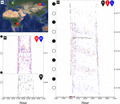- Record: found
- Abstract: found
- Article: found
Lunar synchronization of daily activity patterns in a crepuscular avian insectivore

Read this article at
Abstract
Biological rhythms of nearly all animals on earth are synchronized with natural light and are aligned to day‐and‐night transitions. Here, we test the hypothesis that the lunar cycle affects the nocturnal flight activity of European Nightjars ( Caprimulgus europaeus). We describe daily activity patterns of individuals from three different countries across a wide geographic area, during two discrete periods in the annual cycle. Although the sample size for two of our study sites is small, the results are clear in that on average individual flight activity was strongly correlated with both local variation in day length and with the lunar cycle. We highlight the species’ sensitivity to changes in ambient light and its flexibility to respond to such changes in different parts of the world.
Abstract
Predictable, recurring environmental changes, such as the daily light‐dark cycles, influence both nocturnal and diurnal species and have wide‐ranging effects on their behavior. We describe daily activity patterns of European Nightjars from three extremes of the species’ breeding range, during two discrete periods in the annual cycle. Our study highlights the species’ sensitivity to changes in ambient light and its flexibility to respond to such changes in different parts of the world.
Related collections
Most cited references77
- Record: found
- Abstract: found
- Article: not found
The new world atlas of artificial night sky brightness
- Record: found
- Abstract: not found
- Article: not found
Optimality theory in evolutionary biology
- Record: found
- Abstract: found
- Article: not found
